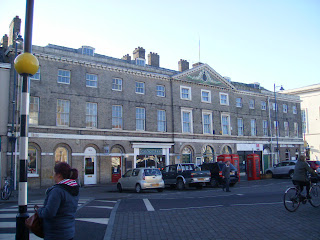The Pilgrims were puritans that were made unwelcome in England. When they tried to escape down the Boston River to Holland, they were captured and tried at the Guildhall in 1607 due to not conforming to the Church of England. Many were released and sailed for the Netherlands a few years later, others left English shores on the Mayflower in 1620 and sailed to New England.
The Guildhall at Boston, Linc's holds 600 years of history.
It was built in 1390s for the Guild of St Mary's. Due to the religious restriction Henry VIII closed and demolished many monasteries and guilds, however in a very clever move Boston became a Borough, Henry VIII handed over what the Guild had owned to this new Borough and the rather rich Guild members applied for the jobs in this new Borough preserving what they considered their due.
This was on the gate to the Guildhall, if anyone knows Latin, maybe you can let us all know what it says please.
This is the old Chapel where Monks and Beadmen would pray for the soul of others. Beadmen were some of the poor of the parish who were taken in, fed and given a bed in exchange for the prays.
This is a view that leads down to the kitchens
From the top of the stairs
The Banquet Hall
Couldn't resist the Gargoyles
The dock and court room where the Pilgrim Fathers were tried
In side the dock were stairs that took you back down to the cells
In the drawers on the left of this photo were very old charter documents, one had a seal with it.
What the open roof looks like with out a ceiling. This roof holds the building together.
The spits in the kitchen
A view from the kitchen area

This plaque is fro the Pilgrim Fathers and their trial
St Botolph's Parish Church, Boston, Lincs
A view of the church tower from the river bank
St Botolph's is also known as the Stump due to it's church tower. Originally the tower was very short due to lack of funding to build it. Today it has the tallest parish church tower in Britain , standing at 83 metres. Work has recently been completed on the outside of this stunning church. In side it is beautiful, though work is still on going at this time.
Blackfriars Arts Centre.
The Blackfriars Arts centre is an old Dominican Friary dating from the 13th century. It was rebuilt in 1309 and became the refectory of the order of Blackfriars, they were also known as shodfriars due to the fact that they wore sandals rather then walking barefoot. It is told that King Edward I was entertained here by the friars. During the dissolution of monasteries the building fell into a long decline. In the 1930's the building was acquired by the Boston Preservation Trust. It is now rebuilt and used as a small theatre and arts centre where many famous people have appeared on stage.
Fydell House
Fydell House was built by Samuel Jackson in 1720, a traditional Georgian home. In 1726 Joseph Fydell a local merchant and cloth importer bought and altered it. Today is still retains it's walled gardens. In 1938 Joseph Kennedy an ambassador of the USA opened the American Room.
The rest of the photos are of buildings that are in and around Boston town. The only photos I have yet to get is of Maud Fosters Windmill and Hussey Tower.
An original Elizabethan House
This was built in 1772
The Assembly Rooms
Look at the lean on this house, it is one of the oldest still standing
I think this is or was the rectory where the vicars live/d
The courthouse
Enjoy the history and photos, leave a message if you wish, I would love to know what you think of the beautiful cities and towns I have visited so far.
































No comments:
Post a Comment